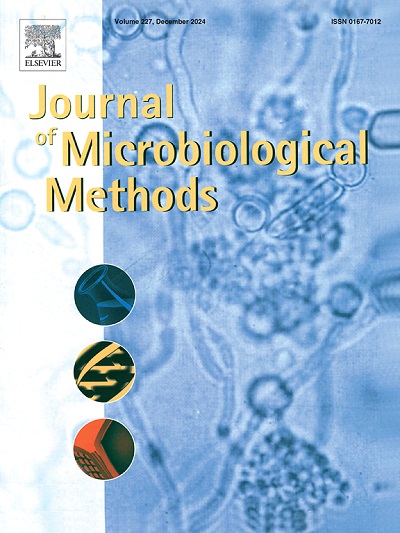用于检测淡水有害藻华蓝藻的通用和分类特异性16S rRNA qPCR引物的设计和验证。
IF 1.7
4区 生物学
Q4 BIOCHEMICAL RESEARCH METHODS
引用次数: 0
摘要
淡水有害藻华形成蓝藻已成为日益突出的全球关注从环境和人类健康的角度。为了使采取预防和缓解措施的决策能够及时作出,需要快速、准确、敏感和定量的工具来检测和监测产生毒素的蓝藻。在这里,我们报告了分类群特异性定量聚合酶链反应(qPCR)引物的开发,该引物能够从非目标群体中区分10个蓝藻属或分支,以及一套新的通用引物,能够扩增所有蓝藻物种。通过4项严格的指标和引物-模板错配进行评估,这些重新设计的qPCR引物在扩增目标菌株的16S rRNA基因方面优于已发表的引物,这些引物来自16个蓝藻菌株,属于10个属。10个表现最好的设计引物使用三个有历史记录的HAB事件的现场样本进行验证。现场验证结果与显微镜观察和全长16S扩增子的纳米孔测序相吻合。我们的研究证明了我们的设计-筛选-评估-验证流程在开发类群特异性qPCR引物以检测和定量类群特异性目标群体方面的有效性,以及它们在现场赤潮样品中的应用前景。随着大规模平行测序技术和生物信息学工具的进步,全群落16S全长测序运行可以提供感兴趣的目标分类群遗传多样性和位点特异性变异信息的全景视图,使新的分类群特异性qPCR分析能够快速发展,并对其进行改进或修改,以适应野外样品的位点特异性遗传变异。本文章由计算机程序翻译,如有差异,请以英文原文为准。

Design and validation of universal and taxon-specific 16S rRNA qPCR primers for detection of freshwater harmful algal bloom-forming cyanobacteria
Freshwater harmful algal bloom-forming cyanobacteria have become an increasingly prominent global concern from both environmental and human health perspectives. To enable and facilitate timely decision making in taking preventative and mitigative measures, rapid, accurate, sensitive and quantitative tools are needed for the detection and monitoring of toxin-producing cyanobacteria. Here we report the development of taxon-specific quantitative polymerase chain reaction (qPCR) primers capable of distinguishing 10 cyanobacterial genera or clade from non-target groups as well as a new set of universal primers capable of amplifying all cyanobacteria species. When evaluated by 4 stringent metrics and primer-template mismatches, these de novo designed qPCR primers outperformed published primers in amplifying the 16S rRNA gene of their target strains among the collection of 16 in-house cyanobacterial strains belonging to 10 genera. The 10 best-performing designed primers were validated using field samples from three field locations with historically documented HAB events. The field validation results corroborated with both microscopic observations and Nanopore sequencing of full-length 16S amplicons. Our study demonstrated the effectiveness of our design-screen-evaluation-validation pipeline in developing taxon-specific qPCR primers for detecting and quantifying group-specific target populations and their promising application to field HABs samples. With the advancement of massive parallel sequencing technologies and bioinformatic tools, a community-wide 16S full-length sequencing run can provide a panoramic view of the genetic diversity and site-specific variant info about the target taxa of interest, enabling the fast development of new taxon-specific qPCR assays and their refinement or modification to adapt to site-specific genetic variations in field samples.
求助全文
通过发布文献求助,成功后即可免费获取论文全文。
去求助
来源期刊

Journal of microbiological methods
生物-生化研究方法
CiteScore
4.30
自引率
4.50%
发文量
151
审稿时长
29 days
期刊介绍:
The Journal of Microbiological Methods publishes scholarly and original articles, notes and review articles. These articles must include novel and/or state-of-the-art methods, or significant improvements to existing methods. Novel and innovative applications of current methods that are validated and useful will also be published. JMM strives for scholarship, innovation and excellence. This demands scientific rigour, the best available methods and technologies, correctly replicated experiments/tests, the inclusion of proper controls, calibrations, and the correct statistical analysis. The presentation of the data must support the interpretation of the method/approach.
All aspects of microbiology are covered, except virology. These include agricultural microbiology, applied and environmental microbiology, bioassays, bioinformatics, biotechnology, biochemical microbiology, clinical microbiology, diagnostics, food monitoring and quality control microbiology, microbial genetics and genomics, geomicrobiology, microbiome methods regardless of habitat, high through-put sequencing methods and analysis, microbial pathogenesis and host responses, metabolomics, metagenomics, metaproteomics, microbial ecology and diversity, microbial physiology, microbial ultra-structure, microscopic and imaging methods, molecular microbiology, mycology, novel mathematical microbiology and modelling, parasitology, plant-microbe interactions, protein markers/profiles, proteomics, pyrosequencing, public health microbiology, radioisotopes applied to microbiology, robotics applied to microbiological methods,rumen microbiology, microbiological methods for space missions and extreme environments, sampling methods and samplers, soil and sediment microbiology, transcriptomics, veterinary microbiology, sero-diagnostics and typing/identification.
 求助内容:
求助内容: 应助结果提醒方式:
应助结果提醒方式:


